2014 MITSUBISHI OUTLANDER SPORT tyre pressure
[x] Cancel search: tyre pressurePage 165 of 388
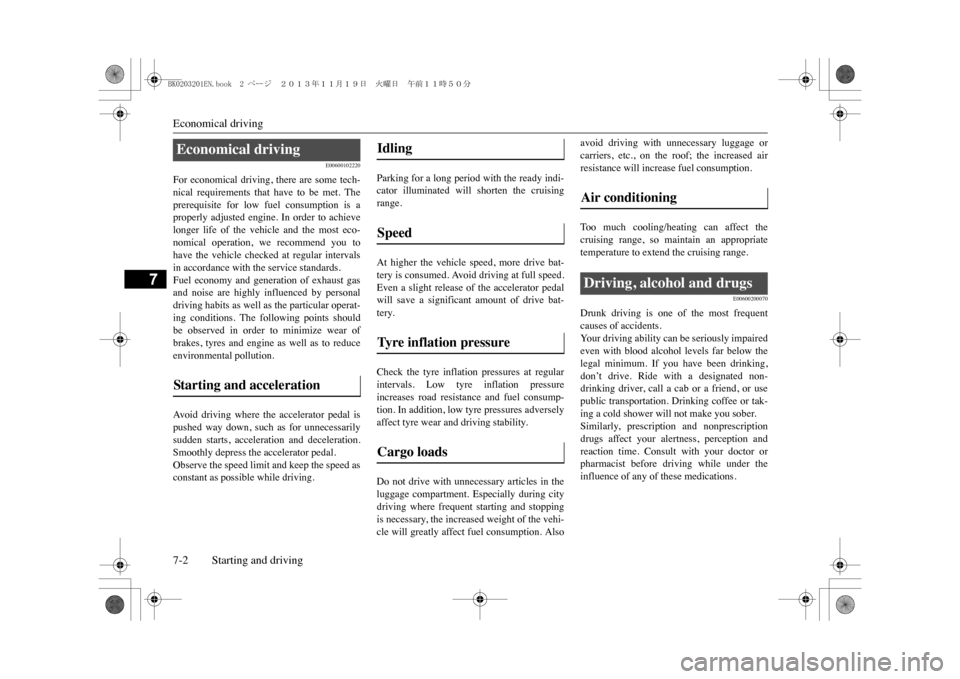
Economical driving7-2 Starting and driving
7
E00600102220
For economical driving, there are some tech-nical requirements that have to be met. Theprerequisite for low fuel consumption is aproperly adjusted engine. In order to achievelonger life of the vehicle and the most eco-nomical operation, we recommend you tohave the vehicle checked at regular intervalsin accordance with the service standards.Fuel economy and generation of exhaust gasand noise are highly influenced by personaldriving habits as well as the particular operat-ing conditions. The following points shouldbe observed in order to minimize wear ofbrakes, tyres and engine as well as to reduceenvironmental pollution.Av o i d d r i v i n g w h e r e t h e a c c e l e r a t o r p e d a l i spushed way down, such as for unnecessarilysudden starts, acceleration and deceleration.Smoothly depress the accelerator pedal.Observe the speed limit and keep the speed asconstant as possible while driving.
Parking for a long period with the ready indi-cator illuminated will shorten the cruisingrange.At higher the vehicle speed, more drive bat-tery is consumed. Avoid driving at full speed.Even a slight release of the accelerator pedalwill save a significant amount of drive bat-tery.Check the tyre inflation pressures at regularintervals. Low tyre inflation pressureincreases road resistance and fuel consump-tion. In addition, low tyre pressures adverselyaffect tyre wear and driving stability.Do not drive with unnecessary articles in theluggage compartment. Especially during citydriving where frequent starting and stoppingis necessary, the increased weight of the vehi-cle will greatly affect fuel consumption. Also
avoid driving with unnecessary luggage orcarriers, etc., on the roof; the increased airresistance will increase fuel consumption.To o m u c h c o o l i n g / h e a t i n g c a n a ff e c t t h ecruising range, so maintain an appropriatetemperature to extend the cruising range.
E00600200070
Drunk driving is one of the most frequentcauses of accidents.Yo u r d r i v i n g a b i l i t y c a n b e s e r i o u s l y i m p a i r e deven with blood alcohol levels far below thelegal minimum. If you have been drinking,don’t drive. Ride with a designated non-drinking driver, call a cab or a friend, or usepublic transportation. Drinking coffee or tak-ing a cold shower will not make you sober.Similarly, prescription and nonprescriptiondrugs affect your alertness, perception andreaction time. Consult with your doctor orpharmacist before driving while under theinfluence of any of these medications.
Economical driving Starting and acceleration
Idling Speed Ty re i n f l a t i o n p r e s s u r e Cargo loads
Air conditioning Driving, alcohol and drugs
BK0203201EN.book 2 ページ 2013年11月19日 火曜日 午前11時50分
Page 184 of 388
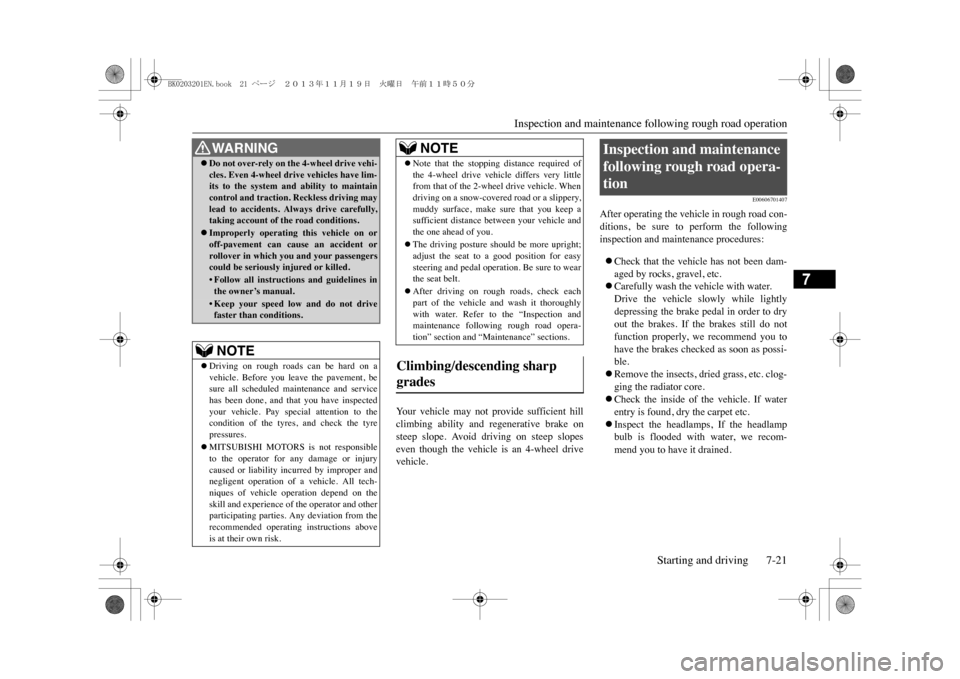
Inspection and maintenance following rough road operation
Starting and driving 7-21
7
Yo u r v e h i c l e m a y n o t p r o v i d e s u f f i c i e n t h i l lclimbing ability and regenerative brake onsteep slope. Avoid driving on steep slopeseven though the vehicle is an 4-wheel drivevehicle.
E00606701407
After operating the vehicle in rough road con-ditions, be sure to perform the followinginspection and maintenance procedures:�zCheck that the vehicle has not been dam-aged by rocks, gravel, etc.�zCarefully wash the vehicle with water.Drive the vehicle slowly while lightlydepressing the brake pedal in order to dryout the brakes. If the brakes still do notfunction properly, we recommend you tohave the brakes checked as soon as possi-ble.�zRemove the insects, dried grass, etc. clog-ging the radiator core.�zCheck the inside of the vehicle. If waterentry is found, dry the carpet etc.�zInspect the headlamps, If the headlampbulb is flooded with water, we recom-mend you to have it drained.
WA R N I N G�zDo not over-rely on the 4-wheel drive vehi-cles. Even 4-wheel drive vehicles have lim-its to the system and ability to maintaincontrol and traction.
Reckless driving may
lead to accidents. Always drive carefully,taking account of the road conditions.�zImproperly operating this vehicle on oroff-pavement can cause an accident orrollover in which you and your passengerscould be seriously injured or killed.•Follow all instructions and guidelines inthe owner’s manual.•Keep your speed low and do not drivefaster than conditions.NOTE
�zDriving on rough roads can be hard on avehicle. Before you leave the pavement, besure all scheduled maintenance and servicehas been done, and that
you have inspected
your vehicle. Pay special attention to thecondition of the tyres, and check the tyrepressures.�zMITSUBISHI MOTORS
is not responsible
to the operator for any damage or injurycaused or liability incurred by improper andnegligent operation of a vehicle. All tech-niques of vehicle operation depend on theskill and experience of the operator and otherparticipating parties.
Any deviation from the
recommended operating instructions aboveis at their own risk.
�zNote that the stopping
distance required of
the 4-wheel drive vehicle differs very littlefrom that of the 2-wheel
drive vehicle. When
driving on a snow-covered
road or a slippery,
muddy surface, make sure that you keep asufficient distance between your vehicle andthe one ahead of you.�zThe driving posture s
hould be more upright;
adjust the seat to a good position for easysteering and pedal operati
on. Be sure to wear
the seat belt.�zAfter driving on rough roads, check eachpart of the vehicle and wash it thoroughlywith water. Refer to the “Inspection andmaintenance following rough road opera-tion” section and “Maintenance” sections.
Climbing/descending sharp grades
NOTE
Inspection and maintenance following rough road opera-tion
BK0203201EN.book 21 ページ 2013年11月19日 火曜日 午前11時50分
Page 185 of 388
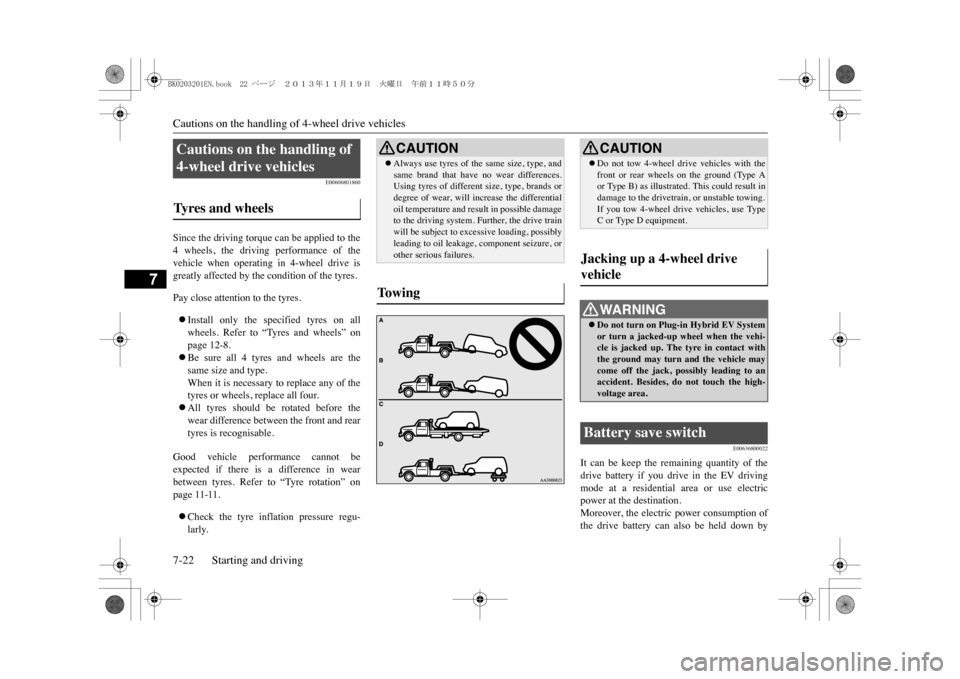
Cautions on the handling of 4-wheel drive vehicles7-22 Starting and driving
7
E00606801860
Since the driving torque can be applied to the4 wheels, the driving performance of thevehicle when operating in 4-wheel drive isgreatly affected by the condition of the tyres.Pay close attention to the tyres.�zInstall only the specified tyres on allwheels. Refer to “Tyres and wheels” onpage 12-8.�zBe sure all 4 tyres and wheels are thesame size and type.When it is necessary to replace any of thetyres or wheels, replace all four.�zAll tyres should be rotated before thewear difference between the front and reartyres is recognisable.
Good vehicle performance cannot beexpected if there is a difference in wearbetween tyres. Refer to “Tyre rotation” onpage 11-11.�zCheck the tyre inflation pressure regu-larly.
E00636800022
It can be keep the remaining quantity of thedrive battery if you drive in the EV drivingmode at a residential area or use electricpower at the destination.Moreover, the electric power consumption ofthe drive battery can also be held down by
Cautions on the handling of 4-wheel drive vehicles Ty r e s a n d w h e e l s
CAUTION�zAlways use tyres of the same size, type, andsame brand that have no wear differences.Using tyres of different size, type, brands ordegree of wear, will increase the differentialoil temperature and result in possible damageto the driving system. Further, the drive trainwill be subject to exce
ssive loading, possibly
leading to oil leakage, component seizure, orother serious failures.
To w i n g
CAUTION�zDo not tow 4-wheel driv
e vehicles with the
front or rear wheels on the ground (Type Aor Type B) as illustrated. This could result indamage to the drivetrain, or unstable towing.If you tow 4-wheel drive vehicles, use TypeC or Type D equipment.
Jacking up a 4-wheel drive vehicle
WA R N I N G�zDo not turn on Plug-in Hybrid EV Systemor turn a jacked-up wheel when the vehi-cle is jacked up. The tyre in contact withthe ground may turn and the vehicle maycome off the jack, possibly leading to anaccident. Besides, do not touch the high-voltage area.
Battery save switch
BK0203201EN.book 22 ページ 2013年11月19日 火曜日 午前11時50分
Page 208 of 388
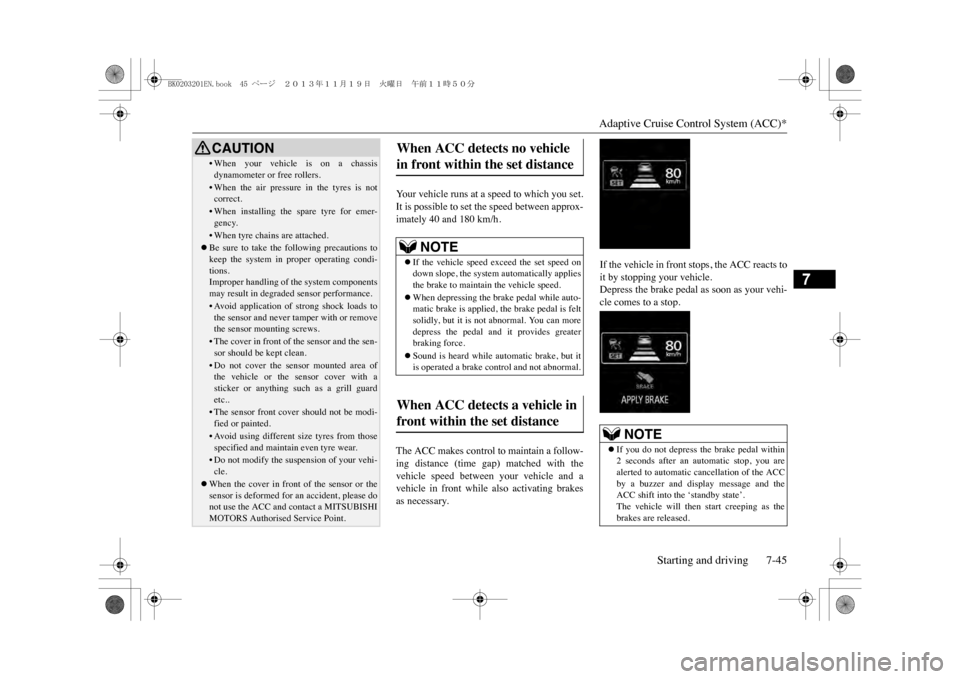
Adaptive Cruise Control System (ACC)*
Starting and driving 7-45
7
Yo u r v e h i c l e r u n s a t a s p e e d t o w h i c h y o u s e t .It is possible to set the speed between approx-imately 40 and 180 km/h.The ACC makes control to maintain a follow-ing distance (time gap) matched with thevehicle speed between your vehicle and avehicle in front while also activating brakesas necessary.
If the vehicle in front stops, the ACC reacts toit by stopping your vehicle.Depress the brake pedal as soon as your vehi-cle comes to a stop.
•When your vehicle is on a chassisdynamometer or free rollers.•When the air pressure in the tyres is notcorrect.•When installing the spare tyre for emer-gency.•When tyre chains are attached.�zBe sure to take the following precautions tokeep the system in proper operating condi-tions.Improper handling of the system componentsmay result in degraded sensor performance.•Avoid application of
strong shock loads to
the sensor and never tamper with or removethe sensor mounting screws.• The cover in front of the sensor and the sen-sor should be kept clean.•Do not cover the sensor mounted area ofthe vehicle or the sensor cover with asticker or anything such as a grill guardetc..•The sensor front cove
r should not be modi-
fied or painted.•Avoid using different
size tyres from those
specified and maintain even tyre wear.•Do not modify the suspension of your vehi-cle.
�zWhen the cover in front of the sensor or thesensor is deformed for an accident, please donot use the ACC and
contact a MITSUBISHI
MOTORS Authorised Service Point.CAUTION
When ACC detects no vehicle in front within the set distance
NOTE
�zIf the vehicle speed exceed the set speed ondown slope, the system automatically appliesthe brake to maintain the vehicle speed.�zWhen depressing the brake pedal while auto-matic brake is applied, the brake pedal is feltsolidly, but it is not abnormal. You can moredepress the pedal and it provides greaterbraking force.�zSound is heard while automatic brake, but itis operated a brake control and not abnormal.
When ACC detects a vehicle in front within the set distance
NOTE
�zIf you do not depress the brake pedal within2 seconds after an automatic stop, you arealerted to automatic cancellation of the ACCby a buzzer and display message and theACC shift into the ‘standby state’.The vehicle will then start creeping as thebrakes are released.
BK0203201EN.book 45 ページ 2013年11月19日 火曜日 午前11時50分
Page 221 of 388
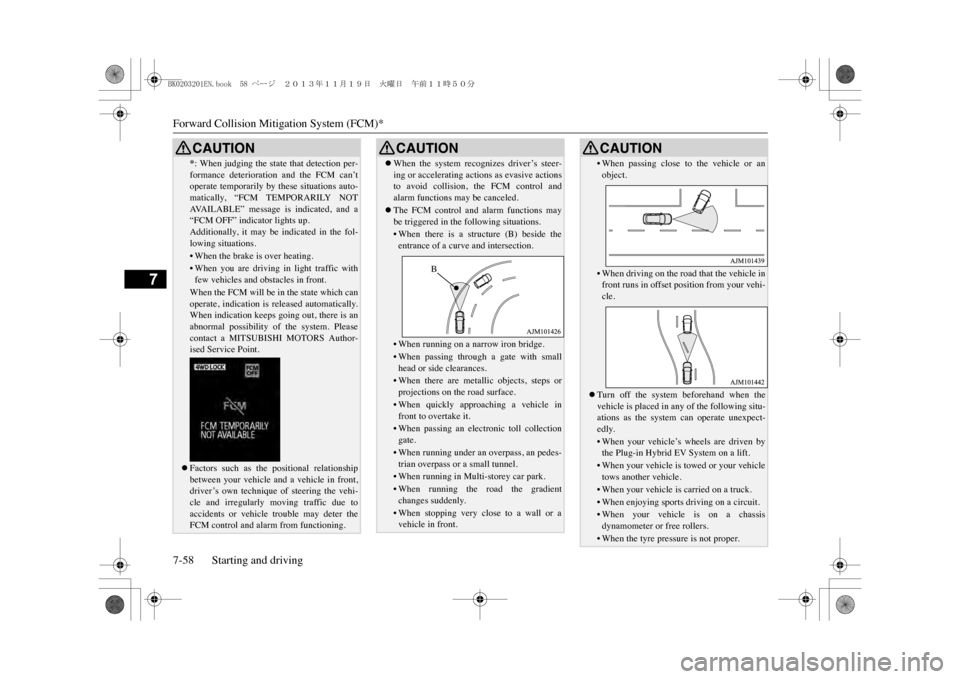
Forward Collision Mitigation System (FCM)*7-58 Starting and driving
7
*: When judging the state that detection per-formance deterioration and the FCM can’toperate temporarily by these situations auto-matically, “FCM TEMPORARILY NOTAVA I L A B L E ” m e s s a g e i s i n d i c a t e d , a n d a“FCM OFF” indicator lights up.Additionally, it may be indicated in the fol-lowing situations.•When the brake is over heating.•When you are driving in light traffic withfew vehicles and obs
tacles in front.
When the FCM will be in the state which canoperate, indication is released automatically.When indication keeps going out, there is anabnormal possibility of the system. Pleasecontact a MITSUBISHI MOTORS Author-ised Service Point.�zFactors such as the positional relationshipbetween your vehicle and a vehicle in front,driver’s own technique of steering the vehi-cle and irregularly moving traffic due toaccidents or vehicle trouble may deter theFCM control and alarm from functioning.CAUTION
�zWhen the system recognizes driver’s steer-ing or accelerating actions as evasive actionsto avoid collision, the FCM control andalarm functions may be canceled.�zThe FCM control and alarm functions maybe triggered in the following situations.•When there is a structure (B) beside theentrance of a curve and intersection.•When running on a na
rrow iron bridge.
•When passing through a gate with smallhead or side clearances.•When there are metallic objects, steps orprojections on the road surface.•When quickly approaching a vehicle infront to overtake it.•When passing an electronic toll collectiongate.•When running under an
overpass, an pedes-
trian overpass or a small tunnel.•When running in Multi-storey car park.•When running the road the gradientchanges suddenly.•When stopping very close to a wall or avehicle in front.CAUTION
B
•When passing close to the vehicle or anobject.•When driving on the road that the vehicle infront runs in offset
position from your vehi-
cle.
�zTurn off the system beforehand when thevehicle is placed in a
ny of the following situ-
ations as the system can operate unexpect-edly.•When your vehicle’s wheels are driven bythe Plug-in Hybrid EV System on a lift.•When your vehicle is towed or your vehicletows another vehicle.•When your vehicle is carried on a truck.•When enjoying sports driving on a circuit.•When your vehicle is on a chassisdynamometer or free rollers.•When the tyre pressure is not proper. CAUTION
BK0203201EN.book 58 ページ 2013年11月19日 火曜日 午前11時50分
Page 226 of 388

Reversing sensor system*
Starting and driving 7-63
7
E00615500374
This system operates when you are backingthe vehicle. It uses corner and back sensors todetect an obstacle and the information screenin the multi information display and thebuzzer to inform you of the approximate dis-tance to the obstacle.
E00615601473
The detection areas of the corner and backsensors are limited to those shown in theillustration. Moreover, the sensors are unableto detect low or thin objects or objects nearthe rear bumper. Thus, make sure to check thesurroundings as you operate the vehicle in asafe manner.There are two corner sensors (A) at the cor-ners of the rear bumper, and two back sensors(B) in the centre of the rear bumper.
•When passing a road section where thenumber of lanes increases/decreases ormultiple lanes are crossing each other.•When the lane is marked by double or oth-erwise special lines.•When driving on a winding or rough road.•When driving on a sli
ppery road covered by
rain water, snow, ice, etc.•When passing through a place where thebrightness suddenly ch
anges, like the inlet
or outlet of a tunnel.•When turning steep curves.•When the road surface is reflecting the lightshining from the direction opposite to therunning direction.•Vehicle largely lurches when it is runningover steps or other irregularities of the roadsurface.•When the headlamp illumination is inade-quate because of contaminated or deterio-rated lenses or improperly aimedheadlamps.•When the vehicle is leaning much to oneside due to heavy l
uggage on it or improp-
erly adjusted tyre pressures.•When oncoming vehicl
es’ headlamps shine
the LDW camera.•When the vehicle is equipped with non-standard tyres (incl
uding excessively worn
tyres), uses snow tr
action device (tyre
chains), or has non-specified componentssuch as a modified suspension.CAUTION
•When the windscreen is covered with rainwater, snow, dust, etc.
�zFollow the instructions given below to keepyour LDW in good operating conditions. •Always keep the windscreen clean.•Avoid applying a str
ong shock or pressure
to the LDW camera. Do not attempt to dis-assemble it.•Disturbing the installation of the LDWcamera or its removal is under no circum-stances permitted. The camera has beenprecisely oriented at the factory.• Do not put anything like a sticker on thearea in front of the LDW camera lens of thewindscreen.•Use only MITSUBISHI MOTORS GENU-INE Parts when replacing the windscreenwipers.
Reversing sensor system
*
CAUTION
CAUTION�zThe reversing sensor system assists you indetermining the approximate distancebetween the vehicle and an obstacle locatedbehind the vehicle. It has limitations in termsof detectable areas and objects, and may notproperly detect some objects. Therefore, donot place excessive confidence in the revers-ing sensor system, and operate the vehicle ascarefully as you would
a vehicle without this
system.�zMake sure to check the surroundings withyour own eyes to ensure safety. Do not oper-ate the vehicle by relying on the reversingsensor system alone.
Obstacle detection areas
Corner and back sensor locations
BK0203201EN.book 63 ページ 2013年11月19日 火曜日 午前11時50分
Page 235 of 388
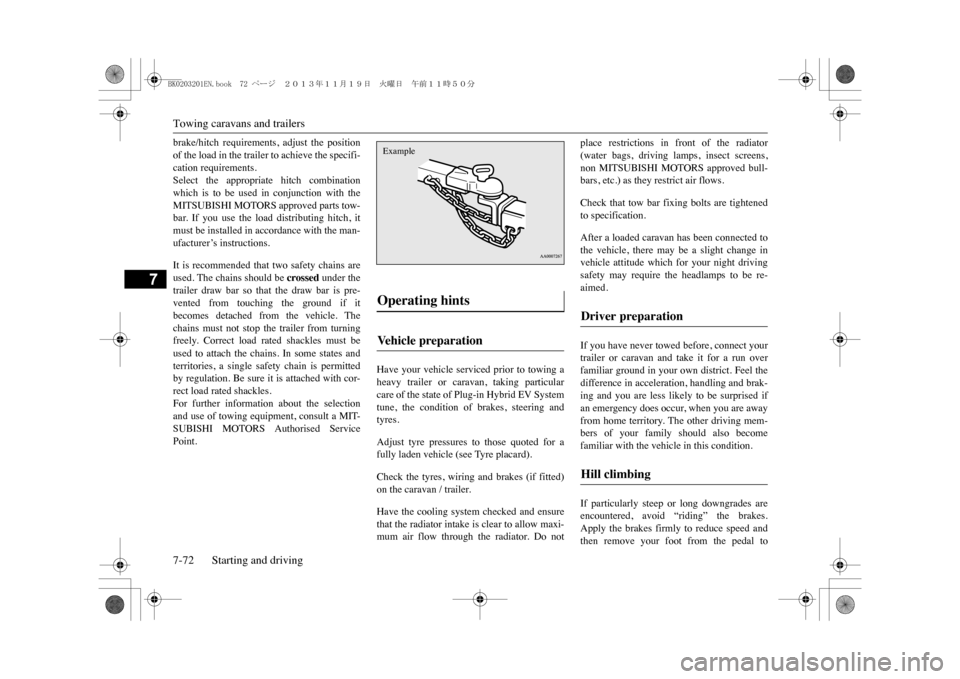
Towing caravans and trailers7-72 Starting and driving
7
brake/hitch requirements, adjust the positionof the load in the trailer to achieve the specifi-cation requirements.Select the appropriate hitch combinationwhich is to be used in conjunction with theMITSUBISHI MOTORS approved parts tow-bar. If you use the load distributing hitch, itmust be installed in accordance with the man-ufacturer’s instructions.It is recommended that two safety chains areused. The chains should be
crossed
under the
trailer draw bar so that the draw bar is pre-vented from touching the ground if itbecomes detached from the vehicle. Thechains must not stop the trailer from turningfreely. Correct load rated shackles must beused to attach the chains. In some states andterritories, a single safety chain is permittedby regulation. Be sure it is attached with cor-rect load rated shackles.For further information about the selectionand use of towing equipment, consult a MIT-SUBISHI MOTORS Authorised ServicePoint.
Have your vehicle serviced prior to towing aheavy trailer or caravan, taking particularcare of the state of Plug-in Hybrid EV Systemtune, the condition of brakes, steering andtyres.Adjust tyre pressures to those quoted for afully laden vehicle (see Tyre placard).Check the tyres, wiring and brakes (if fitted)on the caravan / trailer.Have the cooling system checked and ensurethat the radiator intake is clear to allow maxi-mum air flow through the radiator. Do not
place restrictions in front of the radiator(water bags, driving lamps, insect screens,non MITSUBISHI MOTORS approved bull-bars, etc.) as they restrict air flows.Check that tow bar fixing bolts are tightenedto specification.After a loaded caravan has been connected tothe vehicle, there may be a slight change invehicle attitude which for your night drivingsafety may require the headlamps to be re-aimed.If you have never towed before, connect yourtrailer or caravan and take it for a run overfamiliar ground in your own district. Feel thedifference in acceleration, handling and brak-ing and you are less likely to be surprised ifan emergency does occur, when you are awayfrom home territory. The other driving mem-bers of your family should also becomefamiliar with the vehicle in this condition.If particularly steep or long downgrades areencountered, avoid “riding” the brakes.Apply the brakes firmly to reduce speed andthen remove your foot from the pedal to
Operating hints Ve h i c l e p r e p a r a t i o n Example
Driver preparation Hill climbing
BK0203201EN.book 72 ページ 2013年11月19日 火曜日 午前11時50分
Page 322 of 388
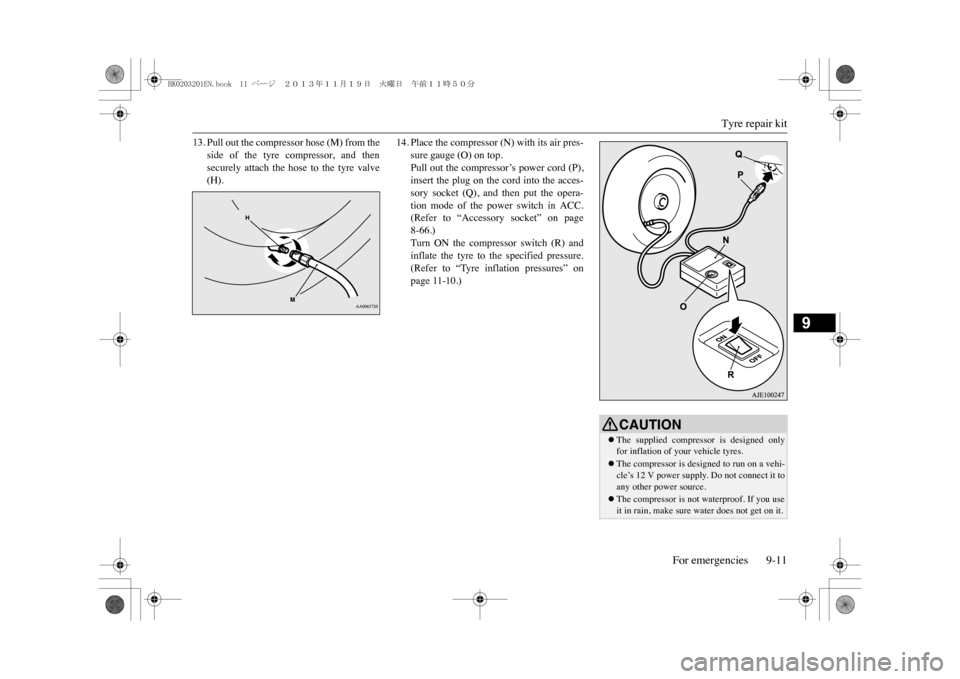
Tyre repair kit
For emergencies 9-11
9
13. Pull out the compressor hose (M) from the
side of the tyre compressor, and thensecurely attach the hose to the tyre valve(H).
14. Place the compressor (N) with its air pres-
sure gauge (O) on top.Pull out the compressor’s power cord (P),insert the plug on the cord into the acces-sory socket (Q), and then put the opera-tion mode of the power switch in ACC.(Refer to “Accessory socket” on page8-66.)Turn ON the compressor switch (R) andinflate the tyre to the specified pressure.(Refer to “Tyre inflation pressures” onpage 11-10.)
CAUTION�zThe supplied compress
or is designed only
for inflation of y
our vehicle tyres.
�zThe compressor is designed to run on a vehi-cle’s 12 V power supply. Do not connect it toany other power source.�zThe compressor is not waterproof. If you useit in rain, make sure water does not get on it.
BK0203201EN.book 11 ページ 2013年11月19日 火曜日 午前11時50分